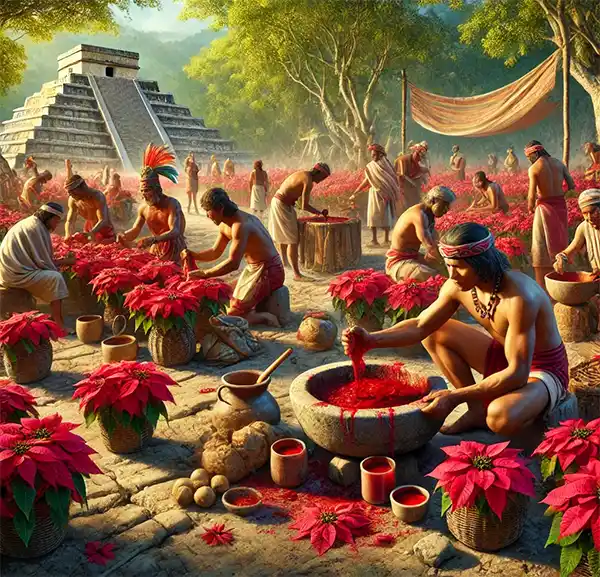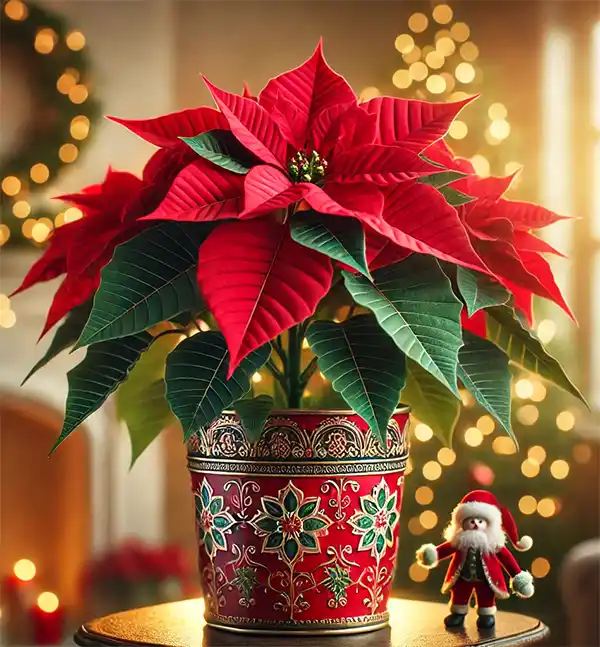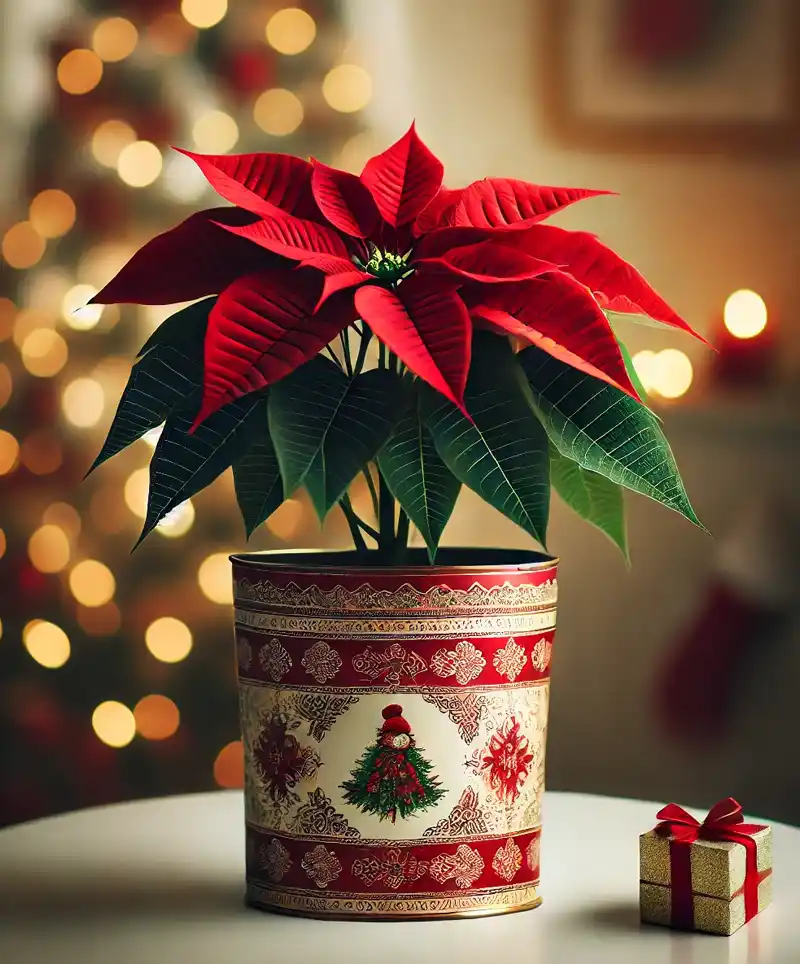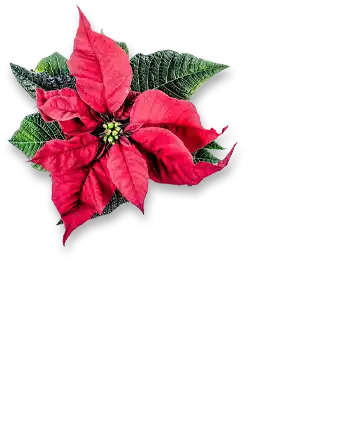Celebrating the Vibrant Holiday Bloom
Each year on December 12th, we set aside time to appreciate the poinsettia—those fiery red, snowy white, or delightful pink plants that are as synonymous with the holiday season as stockings and snowflakes. But there's more to this festive flora than meets the eye. From its roots in Aztec culture to its rise as a holiday staple, the poinsettia has a rich history that deserves a closer look.
The Aztec Origins of the Poinsettia
Long before poinsettias became a holiday staple, they were revered by the Aztecs in their native Mexico, where the plant thrived in the wild. Known as Cuetlaxochitl, which translates roughly to “flower that wilts,” the poinsettia held a place of both practical and spiritual importance in Aztec culture. Its deep red bracts were seen as a symbol of purity and sacrifice, making the plant significant in religious ceremonies.
 But the Aztecs weren’t about symbolism—they were resourceful. The sap of the poinsettia was used medicinally to treat fevers and other ailments, while its vibrant red bracts were turned into a natural dye for textiles and cosmetics. Imagine using poinsettias not just to brighten up your home but also as part of your skincare routine!
But the Aztecs weren’t about symbolism—they were resourceful. The sap of the poinsettia was used medicinally to treat fevers and other ailments, while its vibrant red bracts were turned into a natural dye for textiles and cosmetics. Imagine using poinsettias not just to brighten up your home but also as part of your skincare routine!
This dual role as both a practical and ceremonial plant underscores the ingenuity of the Aztec people, who found ways to make the most of the natural world around them. Though today we admire poinsettias primarily for their beauty, their roots (pun intended) in Aztec culture remind us of their deeper historical significance. It’s a legacy that makes every poinsettia display a little more meaningful, whether it’s adorning a holiday table or simply brightening a chilly winter day.
A Diplomatic Bloom
Fast-forward to the 1820s, when Joel Roberts Poinsett, the first U.S. Minister to Mexico, stumbled upon the poinsettia during his diplomatic tenure. Taken by its striking color and star-like shape, Poinsett shipped cuttings back to his greenhouse in South Carolina. From there, the plant’s popularity spread like wildfire, eventually earning it the common name “poinsettia” in his honor.
It’s worth noting that while Poinsett was undoubtedly a fan of horticulture, his political career was less…blooming. His controversial policies often left people with a thorny impression of him. Thankfully, the poinsettia’s charm outlived any political grumbles.
Not Petals, But Bracts
One of the most surprising facts about poinsettias is that their vibrant red, pink, or white “petals” aren’t petals at all—they’re bracts, which are modified leaves. This botanical quirk often leaves people scratching their heads, but it’s one of the many things that make the poinsettia unique. The real flowers of the poinsettia are the tiny, understated yellow or greenish structures nestled at the center of the bracts. These flowers are so small and subtle that they’re easy to overlook, which seems rather ironic for a plant that’s famous for its bold appearance.
The transformation of the bracts from green to their signature holiday hues is triggered by a process called photoperiodism. When the plant experiences long nights and shorter days, its chlorophyll production slows, allowing other pigments to shine through. This natural spectacle is like a poinsettia’s way of putting on its holiday best, and it requires precise timing and conditions—something greenhouse growers have mastered over the years.
So next time you admire a poinsettia, take a moment to appreciate the science and subtlety behind its showstopping beauty. The bracts may steal the spotlight, but they’re working in harmony with those modest flowers to create one of nature’s most festive displays.
Poinsettias and Holiday Traditions
How did poinsettias become the unofficial plant of Christmas? For that, we turn to Mexico and the legend of Pepita, a young girl with no gift to offer baby Jesus. Inspired by an angel, she gathered a humble bouquet of weeds, which miraculously transformed into bright red poinsettias when placed at the church altar. This story of faith and transformation cemented the poinsettia’s status as a symbol of the season.
 Today, poinsettias are as essential to Christmas décor as candy canes and awkwardly blinking string lights. They’re found everywhere, from department stores to your aunt’s kitchen counter, often accompanied by a slight whiff of overwatering.
Today, poinsettias are as essential to Christmas décor as candy canes and awkwardly blinking string lights. They’re found everywhere, from department stores to your aunt’s kitchen counter, often accompanied by a slight whiff of overwatering.
Care Tips for Your Poinsettia
If you’ve ever owned a poinsettia, you know they can be a bit dramatic. A slight draft? Leaves drop. Too much water? They sulk. Too little water? They stage a full-blown protest. For the best results:
- Keep them in indirect sunlight.
- Water sparingly, allowing the soil to dry out between drinks. Think of them as the Goldilocks of the plant world—not too much, not too little.
- Keep them away from temperature extremes. No one likes a cold snap or a radiator blast, least of all your poinsettia.
While they’re a Christmas classic, poinsettias aren’t just one-season wonders. In their native Mexico, they grow into shrubs or even small trees. Picture a towering poinsettia—proof that even holiday plants dream big.
If you’re feeling adventurous, you can try to keep your poinsettia alive year-round and coax it back into color for next Christmas. This requires patience, precision, and a schedule that rivals a NASA launch. Many find it easier to just buy a new one, which is why garden centers love December.
A Note on Poinsettias and Pets
While this article leans toward a lighthearted tone, here we shift gears to address something truly important: the well-being of your furry companions. Poinsettias have long been the subject of myths regarding their toxicity to pets. Let’s set the record straight while emphasizing the need for caution.
Poinsettias are not deadly to pets, but their sap contains compounds that can cause mild irritation or gastrointestinal upset if ingested. Symptoms may include drooling, vomiting, or diarrhea—none of which sound like a festive experience for your four-legged friends. The good news is that severe poisoning is highly unlikely, but even mild discomfort is too much when it comes to our beloved animals.
To keep your pets safe, consider these precautions:
- Place poinsettias out of reach: Cats, in particular, are notorious climbers and may view your poinsettia as a personal buffet.
- Educate family and guests: Ensure everyone knows to keep an eye on curious pets around holiday plants.
- Monitor for symptoms: If you suspect your pet has nibbled on a poinsettia and they’re showing signs of discomfort, consult your veterinarian for guidance.
This moment of seriousness reflects our love for animals and our desire to ensure they enjoy the holidays as much as we do—without a side trip to the vet. While poinsettias can brighten the season, their beauty should never come at the expense of a pet’s comfort or safety.
Whether you’re captivated by their vivid hues, intrigued by their history, or just using them to hide a less-than-perfect corner of the house, poinsettias are a delightful part of the holiday season. So this National Poinsettia Day, take a moment to appreciate the plant that brings a burst of color to our winter days. Just don’t forget to water it—appropriately.
Please Share our Content






 But the Aztecs weren’t about symbolism—they were resourceful. The sap of the poinsettia was used medicinally to treat fevers and other ailments, while its vibrant red bracts were turned into a natural dye for textiles and cosmetics. Imagine using poinsettias not just to brighten up your home but also as part of your skincare routine!
But the Aztecs weren’t about symbolism—they were resourceful. The sap of the poinsettia was used medicinally to treat fevers and other ailments, while its vibrant red bracts were turned into a natural dye for textiles and cosmetics. Imagine using poinsettias not just to brighten up your home but also as part of your skincare routine! Today, poinsettias are as essential to Christmas décor as candy canes and awkwardly blinking string lights. They’re found everywhere, from department stores to your aunt’s kitchen counter, often accompanied by a slight whiff of overwatering.
Today, poinsettias are as essential to Christmas décor as candy canes and awkwardly blinking string lights. They’re found everywhere, from department stores to your aunt’s kitchen counter, often accompanied by a slight whiff of overwatering.








 "Sláinte!" is a traditional Irish expression used as a toast, equivalent to "Cheers!" in English.
"Sláinte!" is a traditional Irish expression used as a toast, equivalent to "Cheers!" in English.